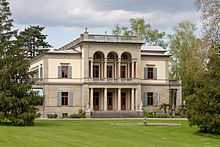Wesendonck Lieder
| Wesendonck Lieder | |
|---|---|
| by Richard Wagner | |
|
Portrait of Mathilde Wesendonck (1850) by Karl Ferdinand Sohn | |
| English | Wesendonck Songs |
| Catalogue | WWV 91 |
| Genre | Song cycle |
| Text | Poems by Mathilde Wesendonck |
| Language | German |
| Composed | 1857-1858 |
| Scoring | voice and piano, orchestra and voice |
Wesendonck Lieder, WWV 91,[1] is the common title of a song cycle by Richard Wagner. He composed the setting of five poems by Mathilde Wesendonck, with titles translating to "The Angel", "Stand still!", "In the Greenhouse", "Sorrows" and "Dreams", while he was working on the Tristan und Isolde opera. The songs and the Siegfried Idyll poem are his only two non-operatic works that are still performed regularly. The Wesendonck Lieder were published under the German title Fünf Gedichte von Mathilde Wesendonk für eine Frauenstimme und Klavier[2] in 1857 and 1858 by C. F. Peters.
History

The cycle is a setting of poems by Mathilde Wesendonck, the wife of one of Richard Wagner's patrons. Wagner had become acquainted with Otto Wesendonck in Zurich, where he had fled on his escape from Saxony after the May Uprising in Dresden in 1849. For a time Wagner and his wife Minna lived together in the Asyl (German for Asylum in the sense of "sanctuary"), a small cottage on the Wesendonck estate.
It is sometimes claimed that Wagner and Mathilde had a love affair; in any case, the situation and mutual infatuation certainly contributed to the intensity in the conception of Tristan und Isolde; there was also certainly an influence on Mathilde's poems.
The poems themselves are in a wistful, pathos-laden style influenced by Wilhelm Müller, the author of the poems used by Schubert earlier in the century. But the language is more rarefied and intense as the Romantic style had developed by that time.
The songs
 |
|
| Problems playing this file? See media help. | |
- "Der Engel" ("The Angel"), composed November 1857
- "Stehe still!" ("Stand still!"), composed February 1858
- "Im Treibhaus – Studie zu Tristan und Isolde" ("In the Greenhouse"), composed May 1858
- "Schmerzen" ("Sorrows"), composed December 1857
- "Träume – Studie zu Tristan und Isolde" ("Dreams"), composed December 1857
Wagner himself called two of the songs in the cycle "studies" for Tristan und Isolde, using for the first time certain musical ideas that are later developed in the opera. In "Träume" can be heard the roots of the love duet in Act 2, while "Im Treibhaus" (the last of the five to be composed) uses music later developed extensively for the prelude to Act 3. The chromatic-harmonic style of Tristan pervades all five songs and pulls the cycle together.
Versions
Wagner initially wrote the songs for female voice and piano alone, but produced an orchestrated version of "Träume", to be performed by chamber orchestra beneath Mathilde's window on the occasion of her birthday, 23 December 1857. The cycle as a whole was first performed in public near Mainz on 30 July 1862 under the title Five Songs for a Female Voice. Some male singers have sung some of the songs: Lauritz Melchior recorded "Schmerzen" and "Träume" for HMV in 1923, "Der Engel" has been recorded by tenors Franco Corelli (in French), Plácido Domingo, Jonas Kaufmann (all), Andrea Bocelli, and the bass Paata Burchuladze. A few have attempted the whole cycle in performance.[3]
The orchestration of the whole cycle was completed for large orchestra by Felix Mottl, the Wagner conductor. In 1972 the Italian composer Vieri Tosatti entirely re-orchestrated the cycle. In 1976 the German composer Hans Werner Henze produced a chamber version for the whole cycle. Each of the players has a separate part, with some very unusual wind registration. French composer Christophe Looten wrote a transcription for voice and string quartet (Théâtre des Champs-Elysées, Paris, March 2015). In 2013 (the bicentennial of Wagner's birth) the French composer Alain Bonardi released a new version for voice, piano, clarinet and cello, including instrumental interludes with oriental resonant percussions. In the same year, the Chinese-British composer Jeffrey Ching premiered two versions of his Wesendonck Sonata, one for voice, viola, and piano, the other for voice, cello, and piano. Ching not only transposed Wagner's original songs so as to form a closed palindromic tonal sequence in the manner of a five-movement sonata, but more importantly composed an elaborate obbligato part for viola (or cello), which both comments on the poems and adds considerable harmonic and contrapuntal detail to Wagner's tame accompaniment (https://www.youtube.com/watch?v=5U7mXz6EQ6M). A version of Ching's Wesendonck Sonata with violin obbligato is scheduled to be premiered in Berlin in April 2015.
Notes
- ↑ A note on the spelling: Otto and Mathilde used the spelling "Wesendonck". Their son called himself Franz von Wesendonk—there were several German spelling reforms at the end of the 19th century. The forms "Wesendonck" and "Wesendonk" are found in roughly equal proportion in Wagner literature.
- ↑ Five poems by Mathilde Wesendonk for a female voice and piano
- ↑ Gurewitsch, Matthew (6 November 2005). "Why Shouldn't Men Sing Romantic Drivel, Too?". The New York Times. Retrieved 3 December 2011.
External links
- Fünf Gedichte für eine Frauenstimme, WWV 91: Scores at the International Music Score Library Project
- Wesendonck-Lieder / fünf Gedichte für eine Frauenstimme und Klavier, WWV 91 / von Richard Wagner nach Texten von Mathilde Wesendonck
- Die Wesendonck-Lieder / Fünf Gedichte für Frauenstimme und Klavier / Komponist: Richard Wagner (WWV 91) wesendonck.websiteportal.de
- The whole cycle re-orchestrated by the Italian composer Vieri Tosatti (1972)
| ||||||||||||||||||||||||||||||||||||||||||||||||||
